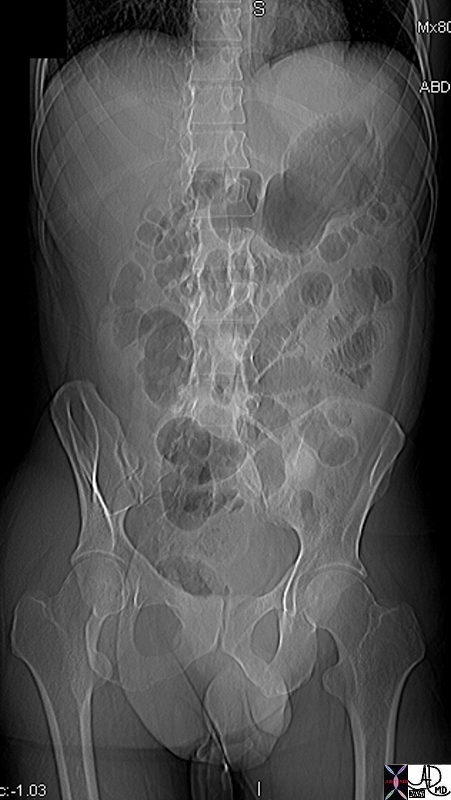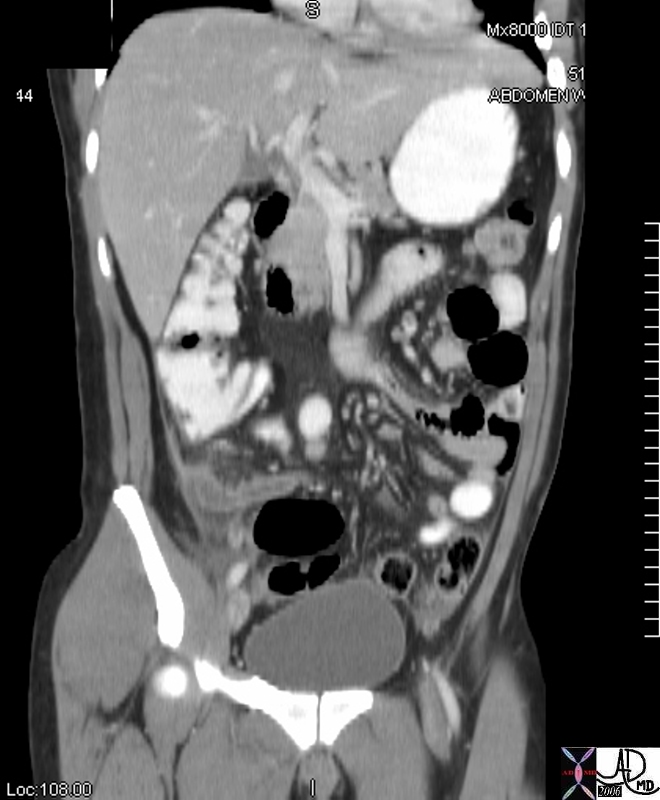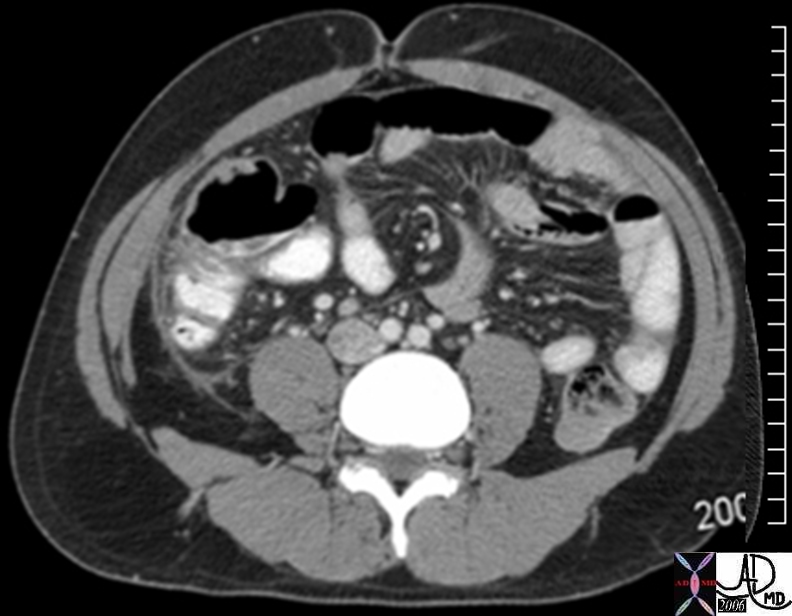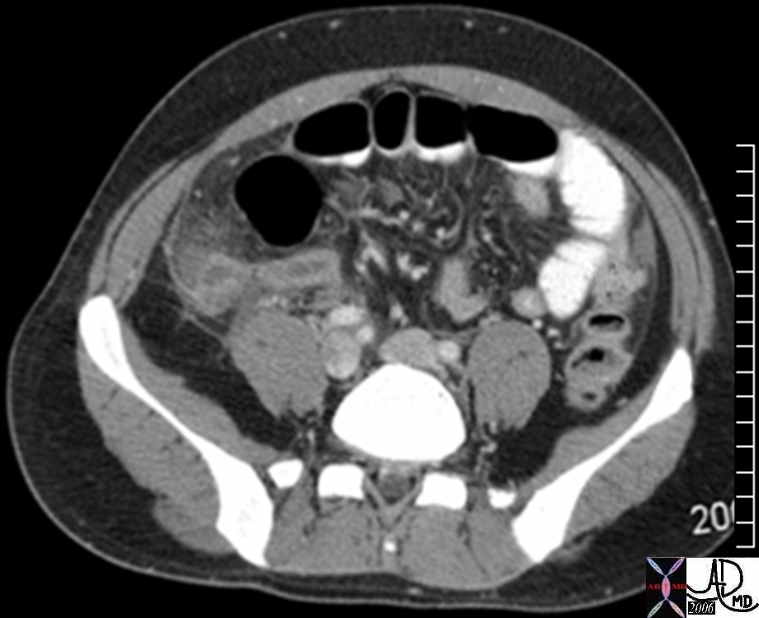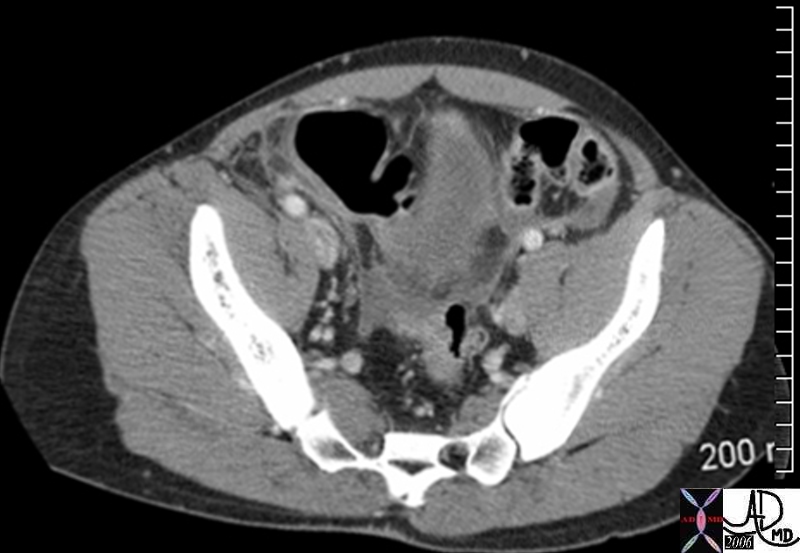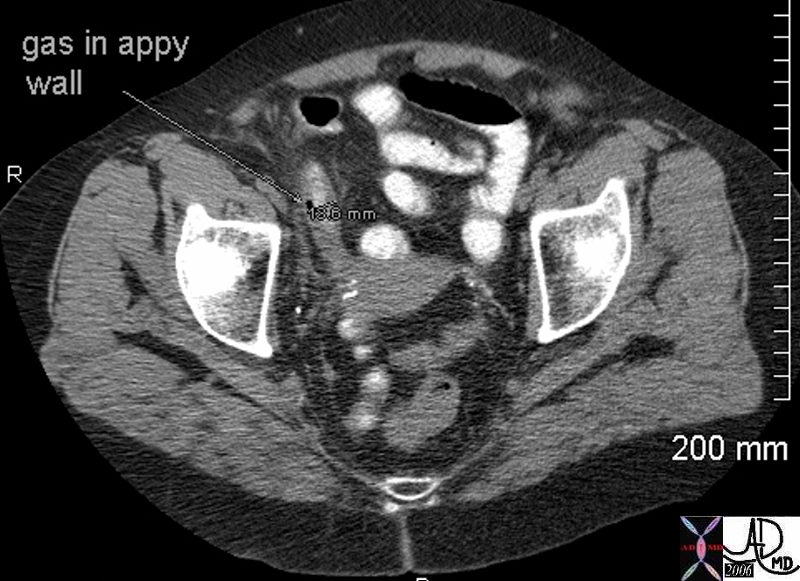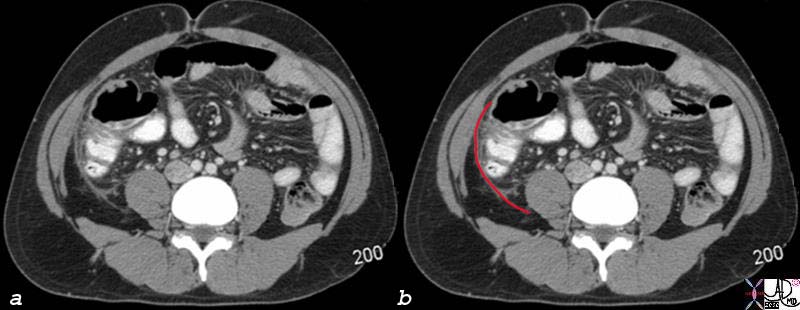Classification of Pain
Clinical Strategies
The Common Vein Copyright 2008
James Armstrong PA
Ashley Davidoff MD
Introduction
Pain is not a homogeneous experience and manifests in a variety of ways. Consequently, there are several ways to classify pain, each with its own merit depending on the context of the case. For instance, pain may be described in terms of its location, character (colicky sharp or dull), duration or other factors. These and other classifications of pain will be explored in this chapter.
Functional Class
Adaptive vs. Maladaptive Pain
It is important to view pain as either adaptive or maladaptive. Adaptive pain is a physiological response that aims to protect the person by limiting activity in favor of healing. Acute or chronic pain can be adaptive. For instance, in the case of rheumatoid arthritis there are acute cycles of inflammation which creates an adaptive response that causes the patient to rest. There is also a subacute or indolent component of healing and repair that is a chronic adaptive pain.
However, in the case of unremitting pain, the entity can become a counterproductive, non-protective encumbrance, irrespective of structural disorder. The pain has become a pathological entity and is no longer adaptive. Psychocultural and psychosocial dynamics also become a large part of the pain syndrome thus requiring a different therapeutic approach.
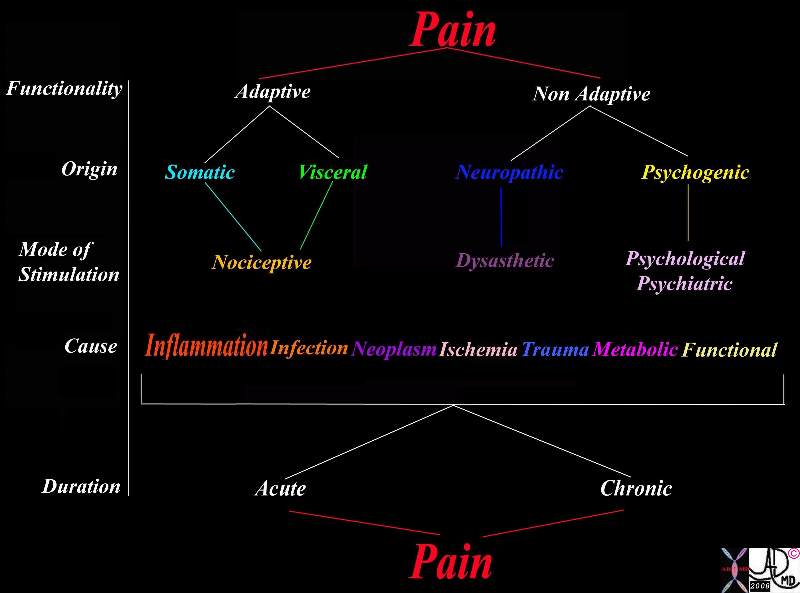
Classification of Pain
|
| The table explores the variety of ways of classifying pain. The left hand column reveals the classification based on functionality, origin, mode of stimulation, pathological causes and relationship of pain to chronicity. As for functionality it may be adaptive or non adaptive. The pain may originate from somatic or visceral nociceptors, may originate from damaged nerves in which case it is called neuropathic, or it may be psychogenic. The causes are usually via the inflammatory process but may result from any of the disease listed.
83199b11.8s pain classification adaptive Non Adaptive somatic visceral nociceptive neuropathic psychogenic dysasthetic psychological psychiatric inflammation infection neoplasm ischemia trauma metabolic functional acute chronic duration cause mode of stimulation origin functionality Courtesy Jamie Armstrong PA Table copyright 2008 |
Classification Based on Origin
Somatic Pain
Somatic pain is caused by direct injury to the skin, pleura, pericardium, peritoneum, muscles, bone, joint, or connective tissues. This type of pain is expressed in a variety of ways depending on the depth and location of the injury. The distribution of the somatic sensorium determines our ability to characterize and locate somatic pain.
From a functional point of view, sensitivity to somatic pain is a protective response and is mostly acute and immediate.
Somatic pain stimuli are mediated by nociceptors that reside in somatic tissue. Indeed, these pain receptors are at their highest concentration in the skin and somatic linings of the body. Pain that is superficial or in an area of abundant nociceptors therefore is described as well localized, sharp, burning or prickly whereas pain in an area of sparse nociceptor distribution is usually described as vague, dull, or aching.
Diagnosis of somatic pain is best accomplished through a thorough patient history and clinical examination. Characteristics of the pain may be deduced by palpation of the affected area. For instance, peritonitis is sensitive to minimal palpation pressure on the abdomen and usually entails rebound tenderness, which is discomfort brought about by slow steady downward pressure followed by a rapid release. The accompanying pain, called pleuritic pain, is acute, immediate, and short-lasting, but sharp. Pleuritic pain is another example of somatic pain. Movement or rubbing of the parietal pleura, which occurs upon inspiration, aggravates this pain even further and may serve as diagnostic indicators of peritonitis.
Treatment of somatic pain is often as simple as removing the insult and/or applying a simple analgesic.
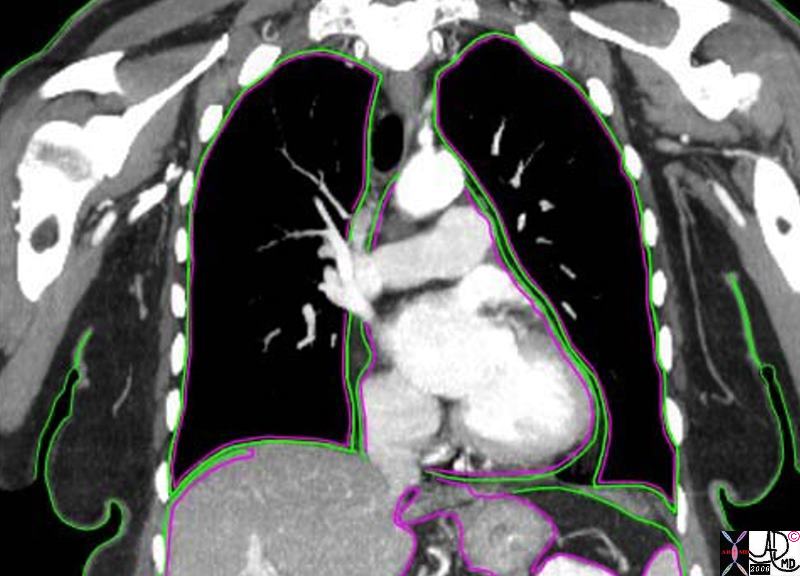
Distribution of Somatic Nociceptors (green) and Visceral Nociceptors (pink) in the Chest
|
|
The example above is a coronal view of the chest as depicted by a CT scan. It demonstrates the somatic (green) and visceral (pink) linings of the chest. The skin as an outer layer contains a large variety and number of nociceptors, as does the outer parietal pleura (somatic -green) surrounding the lungs (black) and parietal pericardium (green) around the contrast filled heart (white). The inner linings of the lung – visceral pleura (pink) and heart’s visceral pericardium (pink) are less endowed with nociceptors both in number and type, while the organs themselves have even less.
The somatic and visceral linings of the organs of the upper abdomen follow the same pattern and will be discussed below in more detail.
82950c07b01.8s skin lungs pleura visceral pleura = pink somatic pleura = parietal pleura = green heart pericardium visceral pericardium = pink parietal pericardium = green peritoneum visceral peritoneum= pink parietal peritoneum = green peritoneal cavity somatic nerves peritoneal nerves somatosensory nerves = green nociceptors chest CTscan Courtesy Ashley Davidoff MD copyright 2008 |

Pleuritic Chest Pain
|
|
The pleuritic pain demonstrated on the right side of this patient is characterized by focal intense (bright red) and sharp pain that is aggravated by deep breaths and by coughing. The location corresponds to the location of the disease. it is explained in the images below.
71197b03p chest lung pleura pleuritic pain PE pulmonary Embolus pneumonia pleurisy aggrrvated by deep inspiration coughing rib fracture pleuritic pain pleurisy CTscan 3D Courtesy Ashley Davidoff MD
|
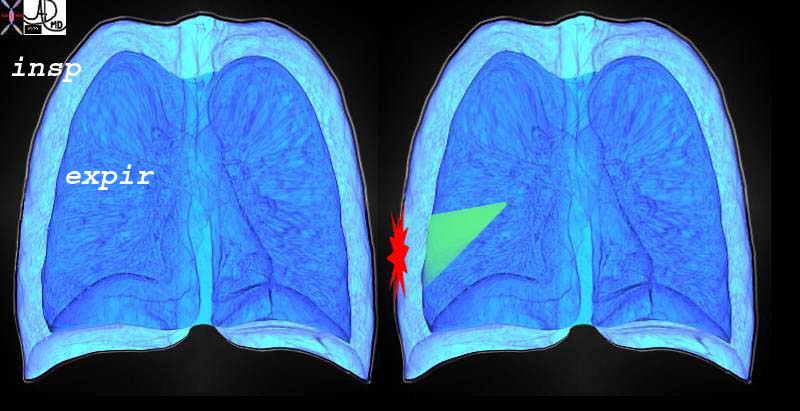
Sharp Intense Pleuritic Pain on Inspiration Due to Pulmonary Embolus and Pulmonary Infarction
|
|
This diagram re-enforces the concept of the pleuritic pain as a somatic pain being related to respiratory movements . The outer part of the diagram represents the expanded lung during inspiration and the inner less voluminous lung represents the deflated lung of expiration. The green wedge represents the infarcted are of lung from the pulmonary embolus that abuts and involves the visceral and parietal pleura. The pain is caused by rubbing on the parietal somatic pleura causing the intense pain (“pleuritic pain”).
42540c02d lung inspiration expiration pain on inspiration focal severe pain pleuritic pain PE pulmonary embolus Davidoff art Courtesy Ashley Davidoff MD
|
Under some circumstances imaging may show enhancement of one of the somatic coverings.
Visceral Pain
Visceral pain is caused by abnormal stretching of the covering or the wall of an organ. Due to the lower concentration of nociceptors in the viscera as compared to somatic tissue, visceral pain is subsequently less localizable.
Functionally, visceral pain is a protective response that serves as both a warning of disease and a means of limiting one?s activity such that further injury may be prevented.
Common causes of visceral pain include obstructions and ruptures of tubular systems in the body leading to distension and ischemia. In the case of the gastrointestinal tract, distension is manifested as colic, or waves of severe pain.
As with somatic pain, visceral pain stimuli are mediated by nociceptors and thus proceed via the same neural pathway through the spinothalamic tract to the thalamus and the inferior portion of the somatosensory cortex. However, these receptors are located deeper within the viscera.
Clinically, visceral pain is often described as long-lasting, unrelenting, sudden in onset, colicky or crampy, vague, ill-defined, or referred. For instance, a patient suffering from angina may complain of chest discomfort radiating to the jaw or left arm. However, the same pain source may cause different symptoms in another patient. This individuality of pain patterns stems from embryological development and unfortunately creates a challenge for the evaluating clinician.
Diagnosis of visceral pain is achieved via thorough clinical history taking, physical examination and medical imaging which is especially useful in identifying obstructions and ruptures. Treating the causes of visceral pain typically involves surgical or other invasive interventions.
 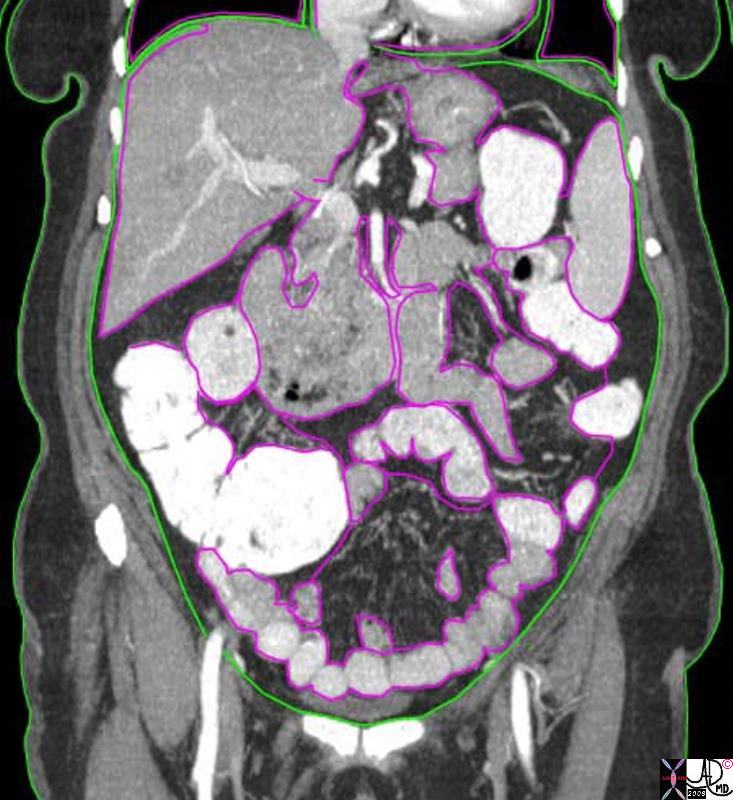
Distribution of Somatic Nociceptors (green) and Visceral Nociceptors (pink) in the Abdomen
|
| In this coronal reconstruction of a CT of the abdomen, the focus is on the pink visceral covering of the liver, spleen and gastrointestinal tract. Pain induced more by stretching of the organ rather than by a pin prick or cut can cause severe discomfort but it is poorly localized and often referred to other regions that have embryological implications.
82950c07b01.8s skin lungs pleura visceral pleura = pink somatic pleura = parietal pleura = green heart pericardium visceral pericardium = pink parietal pericardium = green peritoneum visceral peritoneum= pink parietal peritoneum = green peritoneal cavity somatic nerves peritoneal nerves somatosensory nerves = green nociceptors chest CTscan Courtesy Ashley Davidoff MD copyright 2008 |
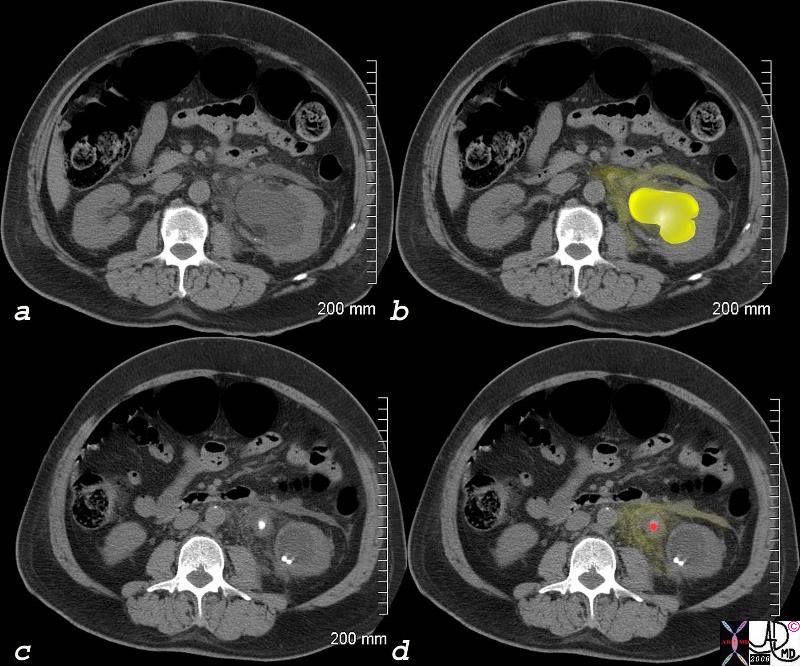
Kidney Stone Obstructing Ureter – Example of Severe Visceral Pain
|
| This patient presented with severe left back pain radiating to his testicle. The CTscan without contrast shows evidence of a stone causing obstruction of the left collecting system. In image a the normal right kidney is seen in relation to the hydronephrotic left kidney with a distended calyces and pelvis (bright yellow in image b). Image stone (red in d) in the middle of the ureter with some leakage of urine into the surrounding tissues. Ureteric pain is one of the most severe pains experienced by people, and its prolonged course, colicky nature, and its pattern of radiation is typical of visceral pain
83142c01.8s left flank pain kidney renal pelvis ureter stones nephrolithiasis ureterolithiasis hydronephrosis pain CTscan Courtesy Ashley Davidoff MD copyright 2008 |
Neuropathic Pain
Injury to any of the peripheral or central nervous system components can be a source of neuropathic pain. This pain classification is unique in that the patient descriptors reflect a derangement in nerve conduction. Symptoms are described as either ?negative? or ?positive? due to respectively diminished or exaggerated sensation when stimulated. Usually the patient expresses neuropathic pain as a burning or an electrical sensation.
Typically neuropathic pain reflects intrinsic, non-traumatic dysfunction of the peripheral nerves caused by damage to components of the sensory system including pain fibers, non-pain fibers, and 1st, 2nd, and 3rd order neurons. However, a variety of traumatic events and disease processes may lead to dyasthetic dysfunction including chronic tissue injury, diabetic neuropathy, thermal injury, electrical burns, chronic repetitive injuries, toxic injuries (chemicals, neurotoxins, chemotherapy), autoimmune diseases, disorders of the thalamus and sensory cortex, and infections like herpes Zoster and HIV.
Psychogenic Pain
Psychogenic pain is a syndrome characterized by seemingly real pain that exists without clinical findings. Instead, there is an underlying psychological disorder that is manifesting as pain. Clinically, the most common symptoms include headaches, muscle or back pain and abdominal pain. There are acute and chronic forms of this syndrome depending on the timing of onset and response to treatment. The cause, intensity or duration of this pain correlates to the degree of mental and/or emotional imbalance.
Mode of Stimulation Class
Nociceptive
Nociceptive pain is experienced when a noxious stimulus like a pinprick, burn, cut, hammer injury, colic, or cramp is perceived. Some of these stimuli are interpreted as sharp pain while others produce an ache or some combination of the two. The structures involved in nociceptive pain include the peripheral sensory first order neurons, the dorsal column of the spine, the spinothalamic tract, the thalamus, and the cortex. Somatic and visceral pain are primarily mediated through nociceptive pathways and may be described functionally by the electromechanical and electrochemical mechanisms that account for its perception. Typical treatment for this type of pain includes local, regional, and epidural anesthesia.
Dyaesthetic
Neuropathic pain is a maladaptive disorder of neuronal tissue characterized by aberrant and often unprovoked dysaestheticimpulses. This pain type does not involve nociceptors.There are subsequently many manifestations including hyperaesthesia (excessive sensitivity), hyperalgesia (excessive pain response), anesthesia (no sensitivity), paresthesia (pins and needles), allodynia (pain produced by a stimulus that would not usually cause pain) and dysaesthesia (aberrant unusual strong sensation).
Diagnosis of neuropathic pain involves a thorough exploration of the patient?s clinical background and history of unusual sensory symptoms. Unfortunately, due to its inferior healing capacity, neuropathic pain often becomes a chronic condition managed only by multiple tiers of therapy.
Psychiatric
Psychogenic pain is most often due to one of the following psychiatric disorders. These include depression, anxiety and bipolar disorder. This pain type is a maladaptive phenomenon of the brain where a biochemical imbalance is expressed as somatic or visceral pain.
The diagnosis of psychogenic pain is one of exclusion and is therefore often difficult to establish without exhausting expensive medical testing and imaging. It is important however for the clinician to understand that irrespective of unsupported findings psychogenic pain feels real to the patient and can cause significant disability. A multi-disciplinary approach with medical and mental health clinicians is therefore required to treat this syndrome and its underlying causes.
Causes – Pathological Classification
Inflammation
The pathological response to any injury in the human body is inflammation.This is an immune mediated storm initiated by increased vascular perfusion and permeability to the area of insult. Next, a fusion of cellular migration and degranulation leads to a release of peptides that stimulate among other things, specialized cellular pain receptors known as proteinases. The subsequent signals generated by inflammation cause symptoms that include burning, aching and pressure. Most causes of tissue injury invoke an inflammatory response. The mechanisms through which patients experience pain differ according to the injury process and tissue response, thus affecting its expression. Below is a summary of classical disease processes, each with a unique mechanism and subsequent pain signal.
Infection
Infection most often manifests as inflammation. However the pattern and subsequent pain are different. Infection by nature delays healing. Pain complaints will therefore be more prolonged and progressive. Subsequently, inflammatory pain from infection will endure, deepen or spread until treatment is initiated.
Neoplasm
Pain in the setting of neoplasm is most often due to the mechanical effect of a tumor on the affected organ or adjacent tissue. Visceral or neuropathic pain will usually occur depending on the affected organ or area. In cases of metastases, bone involvement may become manifest as somatic (throbbing or aching) pain that can override the original neoplastic pain. Cancer therapy may also cause pain due to tissue burns from radiation or localized pain at the sight of a chemotherapy injection.
Circulatory – Ischemia
Insufficient perfusion of tissue leads to hypoxia which is usually manifested as pain. The discomfort may be somatic as in the classic muscular ache of claudication or visceral as described by waxing and waning abdominal pain of ischemic bowel syndrome. The pattern of provoking or relieving factors are helpful descriptors in characterizing the supply and demand mismatch of compromised blood flow.
Trauma
The initiation of a somatic and/or visceral pain stimulus from direct tissue injury constitutes traumatic pain. The usual etiology is an external force, either blunt or penetrating, that is nociceptor mediated. Given the heterogeneity of nociceptor distribution, pain of traumatic origin varies widely according to the degree of injury incurred and the bodily location. Extraneous factors like age and previous pain experiences may influence a person’s reaction to the pain.
Like any other nociceptive pain, trauma can invoke local and systemic physiological and behavioral responses. At the cellular level, prostaglandin release causes inflammation. Systemically, respiration and heart rate can accelerate. Behaviorally, the pain threshold may or may not be reached causing either a minimal reaction or complete withdrawal or immobilization of the body part to spare from further injury. When traumatic pain is severe enough, it may bestow long lasting psychological consequences including Post Traumatic Stress Disorder (PTSD).
Special Categories
Muscular
Another pain pathway in the body arises from gamma sensors located in the muscle spindle apparatus of skeletal muscle. These receptors may be activated at rest or with motor function depending on the source. The most common form of muscular pain occurs after strenuous activity when muscle spindles have become relatively overused through stretching and contracting. The resultant achy pain associated with movement has often been controversially described as secondary to lactic acid and oxygen debt to the muscle fibers. One confounding factor however is that neuropathic pain is also transmitted in the same apparatus but at rest. Patients with spinal cord injuries may suffer from muscular pain as part of a syndrome called Central Pain.
Phantom Pain
The perception of pain following removal of a limb or organ constitutes the poorly understood disorder of phantom pain. The pain is physical and is thought to originate from neurophysiological adaptations in the nociceptor-mediated centers of the brain. However, attention to the treatment of the emotional sequelae that follow amputation or organ removal has been proven effective in mitigating phantom pain.
Classification of Pain Based on Chronicity; Acute and Chronic Pain
The relationship between a healed injury and either the relief or persistence of pain determines whether the experience is acute or chronic.
Acute Pain
Acute pain is is a vital response to a noxious injury and is rapid in onset, can be severe, but is relatively short lasting resolving as the injury heals or is treated. Its tenure depends on the healing rate of the injured tissue and can range from a fleeting moment to weeks or months of gradual relief usually less than 3 months. The usual healing time for tissues is really considered 4-6 weeks.
It is usually caused by mechanical or inflammatory disorders including trauma, obstructions, ruptures, fractures, tears, strains, pulls, infections or acute inflammations.
Structurally it relates to soft tissue damage.
Functionally it is a sensory and protective phenomenon.
The diagnosis is usually resolved by a combination of careful history sometimes requiring an imaging study for further documentation. In the hypracute situation, autonomic responses such as tachycardia and hypertension are often present.
Treatment depends on the cause and may require surgical intervention.
 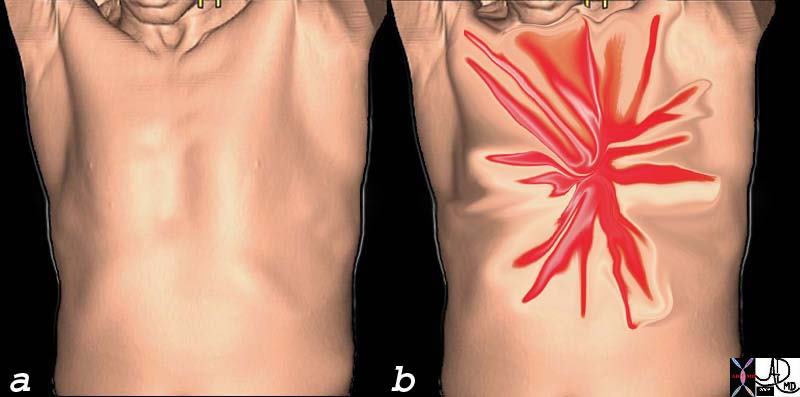
Hyperacute Shearing Chest Pain
|
| Hyperacute shearing and lancinating chest pain characteristic of an acute dissection, is viewed differently from the acute pain or pressure like feeling of an acute myocardial infarction, which in turn is different to the chronic pain of heartburn caused by gastroesophageal reflux disease.
71197c10c chest pain character shearing sharp lancinating acute aortic syndrome aortic dissection penetrating ulcer acute aortic hematoma ruptured aorta ruptured dissection CTscan davidoff Art Courtesy Ashley Davidoff MD 49640c06 |
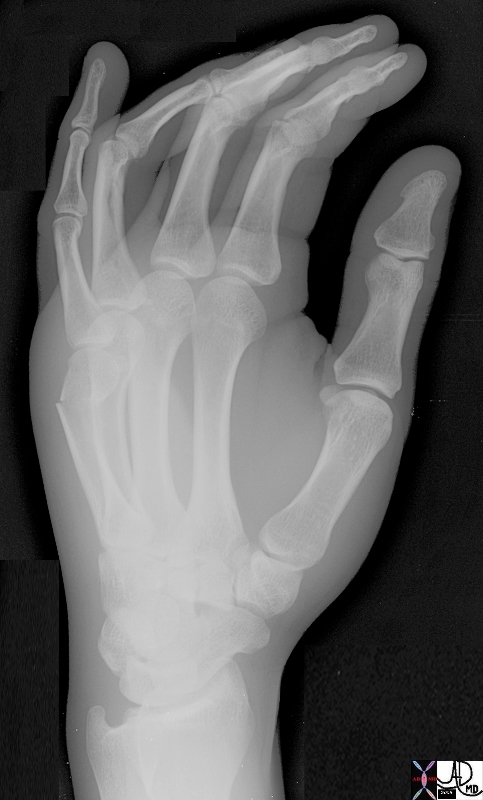
Acute Pain
|
| The X-ray is painful to look at. It shows an acute fracture through the fifth metacarpal and is associated soft tissue injury. Periosteal disruption and injury accounts for the somatic pain experienced.
46800 bone hand metacarpal fx fracture dx boxer’s fracture position alignment post pinning X-ray plain film Davidoff MD Davidoff MD |
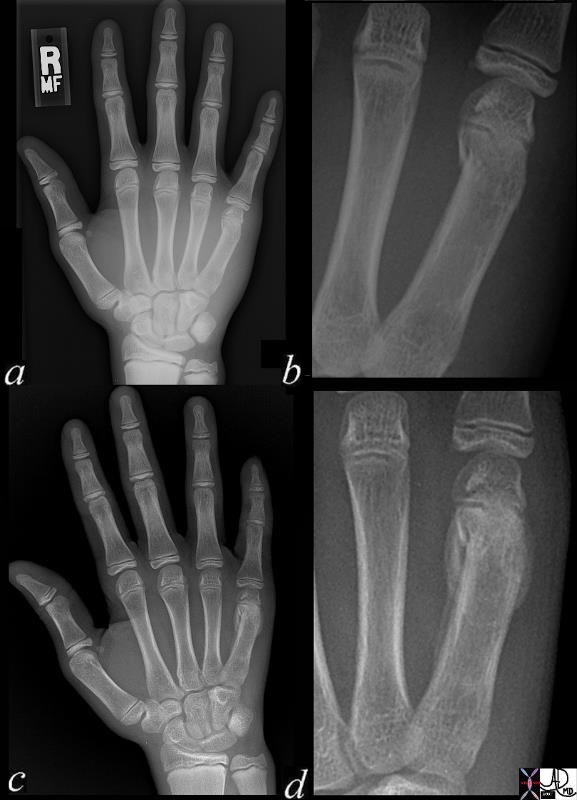
Acute and Subacute Pain
|
| This plain X-ray shows an acute fracture similar to that shown above, except it is of the right 5th metacarpal fracture. It is called a boxer’s fracture since it is usually caused by a male youth hitting a wall in frustration with a closed fist. The bone most vulnerable in this situation is the distal 5th metatarsal.
The acute fracture associated with acute pain is shown in a and b, while a healing fracture which still has minimal pain and discomfort is shown with bridging osteoid in c and d. The pain at this stage is still considered acute since the tissues are still healing.
temper 72175c01.800 15 year old with pain after punching bone hand 5th metacarpal fracture growth plates epiphyses epiphysis Boxer’s fracture four weeks later 4 weeks healing osteoid periosteal reaction osteoclastic activity periosteum plain X-ray plain film Davidoff MD |
Chronic Pain
Chronic pain is that which lasts more than 3 months and/or when pain dwells beyond a realistic healing time. Despite resolution of the injury, there is lingering activation of pain fibers perceived by the patient.
Unlike acute pain which is a survival mechanism, chronic pain is considered a disease state.
The cause of the neuropathic pain is often difficult to find. Rheumatoid arthritis for example is an autoimmune disorder that causes ongoing inflammation. The disease causes an identifiable structural disorder and the chronicity of the disease and the pain is easily understood.
The disorder may have a structural basis in which case diagnosis and treatment is easily accomplished. In the absence of a structural disorder, the syndrome has a bias to psychsocial and cultural origins. Consequently, the diagnosis and treatment is more challenging.
Functionally the disease entity can be incapacitating, irrespective of its structural or psychosocial origin.
Clinical attention to the nature of the pain, duration, precipitating and relieving factors and careful clinical examination are key.
There are often disabling features beyond the sensory manifestations of chronic pain which may aid in the diagnosis. These include motor dysfunction, muscle tension, depression, personality changes, weight gain, anorexia, social withdrawal, and sleep disorders for example, which favor the psychosocial syndrome.
The diagnosis is frequently made clinically and, in the case of true organic disease, appropriate blood tests and imaging enable a diagnosis.
Treatment depends on the diagnosis. When there is structural disorder then treatment is usually straightforward. When pain has a psychosocial origin, treatment is more complex.

Chronic Pain – Rheumatoid Arthritis
|
| The plain film findings of rheumatoid arthritis are graphically depicted in both hands with erosive changes more prominent in the right (R) hand. There is overall ulnar deviation with irregularity and narrowing of the right middle interphalangeal joints on the right and bilateral involvement of the carpo-metacarpal junctions, and both proximal and distal carpal rows. Ongoing inflammation with cycles of destruction and repair lead to chronic pain.
75627.800 bones hands carpal metacarpal interphalangeal joints erosions ulnar deviation joint space loss osteopenia arthritis RA rheumatoid arthritis inflammation shape position wrists plain X-ray plain film Courtesy Ashley Davidoff MD |
DOMElement Object
(
[schemaTypeInfo] =>
[tagName] => table
[firstElementChild] => (object value omitted)
[lastElementChild] => (object value omitted)
[childElementCount] => 1
[previousElementSibling] => (object value omitted)
[nextElementSibling] =>
[nodeName] => table
[nodeValue] =>
Chronic Pain – Rheumatoid Arthritis
The plain film findings of rheumatoid arthritis are graphically depicted in both hands with erosive changes more prominent in the right (R) hand. There is overall ulnar deviation with irregularity and narrowing of the right middle interphalangeal joints on the right and bilateral involvement of the carpo-metacarpal junctions, and both proximal and distal carpal rows. Ongoing inflammation with cycles of destruction and repair lead to chronic pain.
75627.800 bones hands carpal metacarpal interphalangeal joints erosions ulnar deviation joint space loss osteopenia arthritis RA rheumatoid arthritis inflammation shape position wrists plain X-ray plain film Courtesy Ashley Davidoff MD
[nodeType] => 1
[parentNode] => (object value omitted)
[childNodes] => (object value omitted)
[firstChild] => (object value omitted)
[lastChild] => (object value omitted)
[previousSibling] => (object value omitted)
[nextSibling] => (object value omitted)
[attributes] => (object value omitted)
[ownerDocument] => (object value omitted)
[namespaceURI] =>
[prefix] =>
[localName] => table
[baseURI] =>
[textContent] =>
Chronic Pain – Rheumatoid Arthritis
The plain film findings of rheumatoid arthritis are graphically depicted in both hands with erosive changes more prominent in the right (R) hand. There is overall ulnar deviation with irregularity and narrowing of the right middle interphalangeal joints on the right and bilateral involvement of the carpo-metacarpal junctions, and both proximal and distal carpal rows. Ongoing inflammation with cycles of destruction and repair lead to chronic pain.
75627.800 bones hands carpal metacarpal interphalangeal joints erosions ulnar deviation joint space loss osteopenia arthritis RA rheumatoid arthritis inflammation shape position wrists plain X-ray plain film Courtesy Ashley Davidoff MD
)
DOMElement Object
(
[schemaTypeInfo] =>
[tagName] => td
[firstElementChild] => (object value omitted)
[lastElementChild] => (object value omitted)
[childElementCount] => 2
[previousElementSibling] =>
[nextElementSibling] =>
[nodeName] => td
[nodeValue] => The plain film findings of rheumatoid arthritis are graphically depicted in both hands with erosive changes more prominent in the right (R) hand. There is overall ulnar deviation with irregularity and narrowing of the right middle interphalangeal joints on the right and bilateral involvement of the carpo-metacarpal junctions, and both proximal and distal carpal rows. Ongoing inflammation with cycles of destruction and repair lead to chronic pain.
75627.800 bones hands carpal metacarpal interphalangeal joints erosions ulnar deviation joint space loss osteopenia arthritis RA rheumatoid arthritis inflammation shape position wrists plain X-ray plain film Courtesy Ashley Davidoff MD
[nodeType] => 1
[parentNode] => (object value omitted)
[childNodes] => (object value omitted)
[firstChild] => (object value omitted)
[lastChild] => (object value omitted)
[previousSibling] => (object value omitted)
[nextSibling] => (object value omitted)
[attributes] => (object value omitted)
[ownerDocument] => (object value omitted)
[namespaceURI] =>
[prefix] =>
[localName] => td
[baseURI] =>
[textContent] => The plain film findings of rheumatoid arthritis are graphically depicted in both hands with erosive changes more prominent in the right (R) hand. There is overall ulnar deviation with irregularity and narrowing of the right middle interphalangeal joints on the right and bilateral involvement of the carpo-metacarpal junctions, and both proximal and distal carpal rows. Ongoing inflammation with cycles of destruction and repair lead to chronic pain.
75627.800 bones hands carpal metacarpal interphalangeal joints erosions ulnar deviation joint space loss osteopenia arthritis RA rheumatoid arthritis inflammation shape position wrists plain X-ray plain film Courtesy Ashley Davidoff MD
)
DOMElement Object
(
[schemaTypeInfo] =>
[tagName] => td
[firstElementChild] => (object value omitted)
[lastElementChild] => (object value omitted)
[childElementCount] => 2
[previousElementSibling] =>
[nextElementSibling] =>
[nodeName] => td
[nodeValue] =>
Chronic Pain – Rheumatoid Arthritis
[nodeType] => 1
[parentNode] => (object value omitted)
[childNodes] => (object value omitted)
[firstChild] => (object value omitted)
[lastChild] => (object value omitted)
[previousSibling] => (object value omitted)
[nextSibling] => (object value omitted)
[attributes] => (object value omitted)
[ownerDocument] => (object value omitted)
[namespaceURI] =>
[prefix] =>
[localName] => td
[baseURI] =>
[textContent] =>
Chronic Pain – Rheumatoid Arthritis
)
DOMElement Object
(
[schemaTypeInfo] =>
[tagName] => table
[firstElementChild] => (object value omitted)
[lastElementChild] => (object value omitted)
[childElementCount] => 1
[previousElementSibling] => (object value omitted)
[nextElementSibling] => (object value omitted)
[nodeName] => table
[nodeValue] =>
Acute and Subacute Pain
This plain X-ray shows an acute fracture similar to that shown above, except it is of the right 5th metacarpal fracture. It is called a boxer’s fracture since it is usually caused by a male youth hitting a wall in frustration with a closed fist. The bone most vulnerable in this situation is the distal 5th metatarsal.
The acute fracture associated with acute pain is shown in a and b, while a healing fracture which still has minimal pain and discomfort is shown with bridging osteoid in c and d. The pain at this stage is still considered acute since the tissues are still healing.
temper 72175c01.800 15 year old with pain after punching bone hand 5th metacarpal fracture growth plates epiphyses epiphysis Boxer’s fracture four weeks later 4 weeks healing osteoid periosteal reaction osteoclastic activity periosteum plain X-ray plain film Davidoff MD
[nodeType] => 1
[parentNode] => (object value omitted)
[childNodes] => (object value omitted)
[firstChild] => (object value omitted)
[lastChild] => (object value omitted)
[previousSibling] => (object value omitted)
[nextSibling] => (object value omitted)
[attributes] => (object value omitted)
[ownerDocument] => (object value omitted)
[namespaceURI] =>
[prefix] =>
[localName] => table
[baseURI] =>
[textContent] =>
Acute and Subacute Pain
This plain X-ray shows an acute fracture similar to that shown above, except it is of the right 5th metacarpal fracture. It is called a boxer’s fracture since it is usually caused by a male youth hitting a wall in frustration with a closed fist. The bone most vulnerable in this situation is the distal 5th metatarsal.
The acute fracture associated with acute pain is shown in a and b, while a healing fracture which still has minimal pain and discomfort is shown with bridging osteoid in c and d. The pain at this stage is still considered acute since the tissues are still healing.
temper 72175c01.800 15 year old with pain after punching bone hand 5th metacarpal fracture growth plates epiphyses epiphysis Boxer’s fracture four weeks later 4 weeks healing osteoid periosteal reaction osteoclastic activity periosteum plain X-ray plain film Davidoff MD
)
DOMElement Object
(
[schemaTypeInfo] =>
[tagName] => td
[firstElementChild] => (object value omitted)
[lastElementChild] => (object value omitted)
[childElementCount] => 4
[previousElementSibling] =>
[nextElementSibling] =>
[nodeName] => td
[nodeValue] => This plain X-ray shows an acute fracture similar to that shown above, except it is of the right 5th metacarpal fracture. It is called a boxer’s fracture since it is usually caused by a male youth hitting a wall in frustration with a closed fist. The bone most vulnerable in this situation is the distal 5th metatarsal.
The acute fracture associated with acute pain is shown in a and b, while a healing fracture which still has minimal pain and discomfort is shown with bridging osteoid in c and d. The pain at this stage is still considered acute since the tissues are still healing.
temper 72175c01.800 15 year old with pain after punching bone hand 5th metacarpal fracture growth plates epiphyses epiphysis Boxer’s fracture four weeks later 4 weeks healing osteoid periosteal reaction osteoclastic activity periosteum plain X-ray plain film Davidoff MD
[nodeType] => 1
[parentNode] => (object value omitted)
[childNodes] => (object value omitted)
[firstChild] => (object value omitted)
[lastChild] => (object value omitted)
[previousSibling] => (object value omitted)
[nextSibling] => (object value omitted)
[attributes] => (object value omitted)
[ownerDocument] => (object value omitted)
[namespaceURI] =>
[prefix] =>
[localName] => td
[baseURI] =>
[textContent] => This plain X-ray shows an acute fracture similar to that shown above, except it is of the right 5th metacarpal fracture. It is called a boxer’s fracture since it is usually caused by a male youth hitting a wall in frustration with a closed fist. The bone most vulnerable in this situation is the distal 5th metatarsal.
The acute fracture associated with acute pain is shown in a and b, while a healing fracture which still has minimal pain and discomfort is shown with bridging osteoid in c and d. The pain at this stage is still considered acute since the tissues are still healing.
temper 72175c01.800 15 year old with pain after punching bone hand 5th metacarpal fracture growth plates epiphyses epiphysis Boxer’s fracture four weeks later 4 weeks healing osteoid periosteal reaction osteoclastic activity periosteum plain X-ray plain film Davidoff MD
)
DOMElement Object
(
[schemaTypeInfo] =>
[tagName] => td
[firstElementChild] => (object value omitted)
[lastElementChild] => (object value omitted)
[childElementCount] => 2
[previousElementSibling] =>
[nextElementSibling] =>
[nodeName] => td
[nodeValue] =>
Acute and Subacute Pain
[nodeType] => 1
[parentNode] => (object value omitted)
[childNodes] => (object value omitted)
[firstChild] => (object value omitted)
[lastChild] => (object value omitted)
[previousSibling] => (object value omitted)
[nextSibling] => (object value omitted)
[attributes] => (object value omitted)
[ownerDocument] => (object value omitted)
[namespaceURI] =>
[prefix] =>
[localName] => td
[baseURI] =>
[textContent] =>
Acute and Subacute Pain
)
DOMElement Object
(
[schemaTypeInfo] =>
[tagName] => table
[firstElementChild] => (object value omitted)
[lastElementChild] => (object value omitted)
[childElementCount] => 1
[previousElementSibling] => (object value omitted)
[nextElementSibling] => (object value omitted)
[nodeName] => table
[nodeValue] =>
Acute Pain
The X-ray is painful to look at. It shows an acute fracture through the fifth metacarpal and is associated soft tissue injury. Periosteal disruption and injury accounts for the somatic pain experienced.
46800 bone hand metacarpal fx fracture dx boxer’s fracture position alignment post pinning X-ray plain film Davidoff MD Davidoff MD
[nodeType] => 1
[parentNode] => (object value omitted)
[childNodes] => (object value omitted)
[firstChild] => (object value omitted)
[lastChild] => (object value omitted)
[previousSibling] => (object value omitted)
[nextSibling] => (object value omitted)
[attributes] => (object value omitted)
[ownerDocument] => (object value omitted)
[namespaceURI] =>
[prefix] =>
[localName] => table
[baseURI] =>
[textContent] =>
Acute Pain
The X-ray is painful to look at. It shows an acute fracture through the fifth metacarpal and is associated soft tissue injury. Periosteal disruption and injury accounts for the somatic pain experienced.
46800 bone hand metacarpal fx fracture dx boxer’s fracture position alignment post pinning X-ray plain film Davidoff MD Davidoff MD
)
DOMElement Object
(
[schemaTypeInfo] =>
[tagName] => td
[firstElementChild] => (object value omitted)
[lastElementChild] => (object value omitted)
[childElementCount] => 2
[previousElementSibling] =>
[nextElementSibling] =>
[nodeName] => td
[nodeValue] => The X-ray is painful to look at. It shows an acute fracture through the fifth metacarpal and is associated soft tissue injury. Periosteal disruption and injury accounts for the somatic pain experienced.
46800 bone hand metacarpal fx fracture dx boxer’s fracture position alignment post pinning X-ray plain film Davidoff MD Davidoff MD
[nodeType] => 1
[parentNode] => (object value omitted)
[childNodes] => (object value omitted)
[firstChild] => (object value omitted)
[lastChild] => (object value omitted)
[previousSibling] => (object value omitted)
[nextSibling] => (object value omitted)
[attributes] => (object value omitted)
[ownerDocument] => (object value omitted)
[namespaceURI] =>
[prefix] =>
[localName] => td
[baseURI] =>
[textContent] => The X-ray is painful to look at. It shows an acute fracture through the fifth metacarpal and is associated soft tissue injury. Periosteal disruption and injury accounts for the somatic pain experienced.
46800 bone hand metacarpal fx fracture dx boxer’s fracture position alignment post pinning X-ray plain film Davidoff MD Davidoff MD
)
DOMElement Object
(
[schemaTypeInfo] =>
[tagName] => td
[firstElementChild] => (object value omitted)
[lastElementChild] => (object value omitted)
[childElementCount] => 2
[previousElementSibling] =>
[nextElementSibling] =>
[nodeName] => td
[nodeValue] =>
Acute Pain
[nodeType] => 1
[parentNode] => (object value omitted)
[childNodes] => (object value omitted)
[firstChild] => (object value omitted)
[lastChild] => (object value omitted)
[previousSibling] => (object value omitted)
[nextSibling] => (object value omitted)
[attributes] => (object value omitted)
[ownerDocument] => (object value omitted)
[namespaceURI] =>
[prefix] =>
[localName] => td
[baseURI] =>
[textContent] =>
Acute Pain
)
DOMElement Object
(
[schemaTypeInfo] =>
[tagName] => table
[firstElementChild] => (object value omitted)
[lastElementChild] => (object value omitted)
[childElementCount] => 1
[previousElementSibling] => (object value omitted)
[nextElementSibling] => (object value omitted)
[nodeName] => table
[nodeValue] =>
Hyperacute Shearing Chest Pain
Hyperacute shearing and lancinating chest pain characteristic of an acute dissection, is viewed differently from the acute pain or pressure like feeling of an acute myocardial infarction, which in turn is different to the chronic pain of heartburn caused by gastroesophageal reflux disease.
71197c10c chest pain character shearing sharp lancinating acute aortic syndrome aortic dissection penetrating ulcer acute aortic hematoma ruptured aorta ruptured dissection CTscan davidoff Art Courtesy Ashley Davidoff MD 49640c06
[nodeType] => 1
[parentNode] => (object value omitted)
[childNodes] => (object value omitted)
[firstChild] => (object value omitted)
[lastChild] => (object value omitted)
[previousSibling] => (object value omitted)
[nextSibling] => (object value omitted)
[attributes] => (object value omitted)
[ownerDocument] => (object value omitted)
[namespaceURI] =>
[prefix] =>
[localName] => table
[baseURI] =>
[textContent] =>
Hyperacute Shearing Chest Pain
Hyperacute shearing and lancinating chest pain characteristic of an acute dissection, is viewed differently from the acute pain or pressure like feeling of an acute myocardial infarction, which in turn is different to the chronic pain of heartburn caused by gastroesophageal reflux disease.
71197c10c chest pain character shearing sharp lancinating acute aortic syndrome aortic dissection penetrating ulcer acute aortic hematoma ruptured aorta ruptured dissection CTscan davidoff Art Courtesy Ashley Davidoff MD 49640c06
)
DOMElement Object
(
[schemaTypeInfo] =>
[tagName] => td
[firstElementChild] => (object value omitted)
[lastElementChild] => (object value omitted)
[childElementCount] => 2
[previousElementSibling] =>
[nextElementSibling] =>
[nodeName] => td
[nodeValue] => Hyperacute shearing and lancinating chest pain characteristic of an acute dissection, is viewed differently from the acute pain or pressure like feeling of an acute myocardial infarction, which in turn is different to the chronic pain of heartburn caused by gastroesophageal reflux disease.
71197c10c chest pain character shearing sharp lancinating acute aortic syndrome aortic dissection penetrating ulcer acute aortic hematoma ruptured aorta ruptured dissection CTscan davidoff Art Courtesy Ashley Davidoff MD 49640c06
[nodeType] => 1
[parentNode] => (object value omitted)
[childNodes] => (object value omitted)
[firstChild] => (object value omitted)
[lastChild] => (object value omitted)
[previousSibling] => (object value omitted)
[nextSibling] => (object value omitted)
[attributes] => (object value omitted)
[ownerDocument] => (object value omitted)
[namespaceURI] =>
[prefix] =>
[localName] => td
[baseURI] =>
[textContent] => Hyperacute shearing and lancinating chest pain characteristic of an acute dissection, is viewed differently from the acute pain or pressure like feeling of an acute myocardial infarction, which in turn is different to the chronic pain of heartburn caused by gastroesophageal reflux disease.
71197c10c chest pain character shearing sharp lancinating acute aortic syndrome aortic dissection penetrating ulcer acute aortic hematoma ruptured aorta ruptured dissection CTscan davidoff Art Courtesy Ashley Davidoff MD 49640c06
)
DOMElement Object
(
[schemaTypeInfo] =>
[tagName] => td
[firstElementChild] => (object value omitted)
[lastElementChild] => (object value omitted)
[childElementCount] => 2
[previousElementSibling] =>
[nextElementSibling] =>
[nodeName] => td
[nodeValue] =>
Hyperacute Shearing Chest Pain
[nodeType] => 1
[parentNode] => (object value omitted)
[childNodes] => (object value omitted)
[firstChild] => (object value omitted)
[lastChild] => (object value omitted)
[previousSibling] => (object value omitted)
[nextSibling] => (object value omitted)
[attributes] => (object value omitted)
[ownerDocument] => (object value omitted)
[namespaceURI] =>
[prefix] =>
[localName] => td
[baseURI] =>
[textContent] =>
Hyperacute Shearing Chest Pain
)
https://beta.thecommonvein.net/wp-content/uploads/2023/06/71197c10c.jpg https://beta.thecommonvein.net/wp-content/uploads/2023/06/49640c06.jpg
http://thecommonvein.net/media/71197c10c.jpg
DOMElement Object
(
[schemaTypeInfo] =>
[tagName] => table
[firstElementChild] => (object value omitted)
[lastElementChild] => (object value omitted)
[childElementCount] => 1
[previousElementSibling] => (object value omitted)
[nextElementSibling] => (object value omitted)
[nodeName] => table
[nodeValue] =>
Kidney Stone Obstructing Ureter – Example of Severe Visceral Pain
This patient presented with severe left back pain radiating to his testicle. The CTscan without contrast shows evidence of a stone causing obstruction of the left collecting system. In image a the normal right kidney is seen in relation to the hydronephrotic left kidney with a distended calyces and pelvis (bright yellow in image b). Image stone (red in d) in the middle of the ureter with some leakage of urine into the surrounding tissues. Ureteric pain is one of the most severe pains experienced by people, and its prolonged course, colicky nature, and its pattern of radiation is typical of visceral pain
83142c01.8s left flank pain kidney renal pelvis ureter stones nephrolithiasis ureterolithiasis hydronephrosis pain CTscan Courtesy Ashley Davidoff MD copyright 2008
[nodeType] => 1
[parentNode] => (object value omitted)
[childNodes] => (object value omitted)
[firstChild] => (object value omitted)
[lastChild] => (object value omitted)
[previousSibling] => (object value omitted)
[nextSibling] => (object value omitted)
[attributes] => (object value omitted)
[ownerDocument] => (object value omitted)
[namespaceURI] =>
[prefix] =>
[localName] => table
[baseURI] =>
[textContent] =>
Kidney Stone Obstructing Ureter – Example of Severe Visceral Pain
This patient presented with severe left back pain radiating to his testicle. The CTscan without contrast shows evidence of a stone causing obstruction of the left collecting system. In image a the normal right kidney is seen in relation to the hydronephrotic left kidney with a distended calyces and pelvis (bright yellow in image b). Image stone (red in d) in the middle of the ureter with some leakage of urine into the surrounding tissues. Ureteric pain is one of the most severe pains experienced by people, and its prolonged course, colicky nature, and its pattern of radiation is typical of visceral pain
83142c01.8s left flank pain kidney renal pelvis ureter stones nephrolithiasis ureterolithiasis hydronephrosis pain CTscan Courtesy Ashley Davidoff MD copyright 2008
)
DOMElement Object
(
[schemaTypeInfo] =>
[tagName] => td
[firstElementChild] => (object value omitted)
[lastElementChild] => (object value omitted)
[childElementCount] => 2
[previousElementSibling] =>
[nextElementSibling] =>
[nodeName] => td
[nodeValue] => This patient presented with severe left back pain radiating to his testicle. The CTscan without contrast shows evidence of a stone causing obstruction of the left collecting system. In image a the normal right kidney is seen in relation to the hydronephrotic left kidney with a distended calyces and pelvis (bright yellow in image b). Image stone (red in d) in the middle of the ureter with some leakage of urine into the surrounding tissues. Ureteric pain is one of the most severe pains experienced by people, and its prolonged course, colicky nature, and its pattern of radiation is typical of visceral pain
83142c01.8s left flank pain kidney renal pelvis ureter stones nephrolithiasis ureterolithiasis hydronephrosis pain CTscan Courtesy Ashley Davidoff MD copyright 2008
[nodeType] => 1
[parentNode] => (object value omitted)
[childNodes] => (object value omitted)
[firstChild] => (object value omitted)
[lastChild] => (object value omitted)
[previousSibling] => (object value omitted)
[nextSibling] => (object value omitted)
[attributes] => (object value omitted)
[ownerDocument] => (object value omitted)
[namespaceURI] =>
[prefix] =>
[localName] => td
[baseURI] =>
[textContent] => This patient presented with severe left back pain radiating to his testicle. The CTscan without contrast shows evidence of a stone causing obstruction of the left collecting system. In image a the normal right kidney is seen in relation to the hydronephrotic left kidney with a distended calyces and pelvis (bright yellow in image b). Image stone (red in d) in the middle of the ureter with some leakage of urine into the surrounding tissues. Ureteric pain is one of the most severe pains experienced by people, and its prolonged course, colicky nature, and its pattern of radiation is typical of visceral pain
83142c01.8s left flank pain kidney renal pelvis ureter stones nephrolithiasis ureterolithiasis hydronephrosis pain CTscan Courtesy Ashley Davidoff MD copyright 2008
)
DOMElement Object
(
[schemaTypeInfo] =>
[tagName] => td
[firstElementChild] => (object value omitted)
[lastElementChild] => (object value omitted)
[childElementCount] => 2
[previousElementSibling] =>
[nextElementSibling] =>
[nodeName] => td
[nodeValue] =>
Kidney Stone Obstructing Ureter – Example of Severe Visceral Pain
[nodeType] => 1
[parentNode] => (object value omitted)
[childNodes] => (object value omitted)
[firstChild] => (object value omitted)
[lastChild] => (object value omitted)
[previousSibling] => (object value omitted)
[nextSibling] => (object value omitted)
[attributes] => (object value omitted)
[ownerDocument] => (object value omitted)
[namespaceURI] =>
[prefix] =>
[localName] => td
[baseURI] =>
[textContent] =>
Kidney Stone Obstructing Ureter – Example of Severe Visceral Pain
)
DOMElement Object
(
[schemaTypeInfo] =>
[tagName] => table
[firstElementChild] => (object value omitted)
[lastElementChild] => (object value omitted)
[childElementCount] => 1
[previousElementSibling] => (object value omitted)
[nextElementSibling] => (object value omitted)
[nodeName] => table
[nodeValue] =>
Distribution of Somatic Nociceptors (green) and Visceral Nociceptors (pink) in the Abdomen
In this coronal reconstruction of a CT of the abdomen, the focus is on the pink visceral covering of the liver, spleen and gastrointestinal tract. Pain induced more by stretching of the organ rather than by a pin prick or cut can cause severe discomfort but it is poorly localized and often referred to other regions that have embryological implications.
82950c07b01.8s skin lungs pleura visceral pleura = pink somatic pleura = parietal pleura = green heart pericardium visceral pericardium = pink parietal pericardium = green peritoneum visceral peritoneum= pink parietal peritoneum = green peritoneal cavity somatic nerves peritoneal nerves somatosensory nerves = green nociceptors chest CTscan Courtesy Ashley Davidoff MD copyright 2008
[nodeType] => 1
[parentNode] => (object value omitted)
[childNodes] => (object value omitted)
[firstChild] => (object value omitted)
[lastChild] => (object value omitted)
[previousSibling] => (object value omitted)
[nextSibling] => (object value omitted)
[attributes] => (object value omitted)
[ownerDocument] => (object value omitted)
[namespaceURI] =>
[prefix] =>
[localName] => table
[baseURI] =>
[textContent] =>
Distribution of Somatic Nociceptors (green) and Visceral Nociceptors (pink) in the Abdomen
In this coronal reconstruction of a CT of the abdomen, the focus is on the pink visceral covering of the liver, spleen and gastrointestinal tract. Pain induced more by stretching of the organ rather than by a pin prick or cut can cause severe discomfort but it is poorly localized and often referred to other regions that have embryological implications.
82950c07b01.8s skin lungs pleura visceral pleura = pink somatic pleura = parietal pleura = green heart pericardium visceral pericardium = pink parietal pericardium = green peritoneum visceral peritoneum= pink parietal peritoneum = green peritoneal cavity somatic nerves peritoneal nerves somatosensory nerves = green nociceptors chest CTscan Courtesy Ashley Davidoff MD copyright 2008
)
DOMElement Object
(
[schemaTypeInfo] =>
[tagName] => td
[firstElementChild] => (object value omitted)
[lastElementChild] => (object value omitted)
[childElementCount] => 2
[previousElementSibling] =>
[nextElementSibling] =>
[nodeName] => td
[nodeValue] => In this coronal reconstruction of a CT of the abdomen, the focus is on the pink visceral covering of the liver, spleen and gastrointestinal tract. Pain induced more by stretching of the organ rather than by a pin prick or cut can cause severe discomfort but it is poorly localized and often referred to other regions that have embryological implications.
82950c07b01.8s skin lungs pleura visceral pleura = pink somatic pleura = parietal pleura = green heart pericardium visceral pericardium = pink parietal pericardium = green peritoneum visceral peritoneum= pink parietal peritoneum = green peritoneal cavity somatic nerves peritoneal nerves somatosensory nerves = green nociceptors chest CTscan Courtesy Ashley Davidoff MD copyright 2008
[nodeType] => 1
[parentNode] => (object value omitted)
[childNodes] => (object value omitted)
[firstChild] => (object value omitted)
[lastChild] => (object value omitted)
[previousSibling] => (object value omitted)
[nextSibling] => (object value omitted)
[attributes] => (object value omitted)
[ownerDocument] => (object value omitted)
[namespaceURI] =>
[prefix] =>
[localName] => td
[baseURI] =>
[textContent] => In this coronal reconstruction of a CT of the abdomen, the focus is on the pink visceral covering of the liver, spleen and gastrointestinal tract. Pain induced more by stretching of the organ rather than by a pin prick or cut can cause severe discomfort but it is poorly localized and often referred to other regions that have embryological implications.
82950c07b01.8s skin lungs pleura visceral pleura = pink somatic pleura = parietal pleura = green heart pericardium visceral pericardium = pink parietal pericardium = green peritoneum visceral peritoneum= pink parietal peritoneum = green peritoneal cavity somatic nerves peritoneal nerves somatosensory nerves = green nociceptors chest CTscan Courtesy Ashley Davidoff MD copyright 2008
)
DOMElement Object
(
[schemaTypeInfo] =>
[tagName] => td
[firstElementChild] => (object value omitted)
[lastElementChild] => (object value omitted)
[childElementCount] => 2
[previousElementSibling] =>
[nextElementSibling] =>
[nodeName] => td
[nodeValue] =>
Distribution of Somatic Nociceptors (green) and Visceral Nociceptors (pink) in the Abdomen
[nodeType] => 1
[parentNode] => (object value omitted)
[childNodes] => (object value omitted)
[firstChild] => (object value omitted)
[lastChild] => (object value omitted)
[previousSibling] => (object value omitted)
[nextSibling] => (object value omitted)
[attributes] => (object value omitted)
[ownerDocument] => (object value omitted)
[namespaceURI] =>
[prefix] =>
[localName] => td
[baseURI] =>
[textContent] =>
Distribution of Somatic Nociceptors (green) and Visceral Nociceptors (pink) in the Abdomen
)
https://beta.thecommonvein.net/wp-content/uploads/2023/09/82950c07b01.8s.jpg
http://thecommonvein.net/media/82950c07b02.8s.jpg
DOMElement Object
(
[schemaTypeInfo] =>
[tagName] => table
[firstElementChild] => (object value omitted)
[lastElementChild] => (object value omitted)
[childElementCount] => 1
[previousElementSibling] => (object value omitted)
[nextElementSibling] => (object value omitted)
[nodeName] => table
[nodeValue] =>
Peritoneal Thickening in the Right Lower Quadrant in Appendicitis
This young male presented with right lower quadrant fever, peritonism and rebound tenderness and a thickened appendix and thickened peritoneum (red line) was noted on the CTscan. The diagnosis of acute appendicitis was apparent both clinically and radiologcally and at surgery a hemorrhagic appendicitis was found.
colon abdominal fat peritoneum peritoneal cavity fx enlarged dilated thickened and thickening of the peritoneum and peritoneal lining around cecum fx induration edematous edema dx acute appendicitis complicated by hemorrhagic hemorrhage bleeding with necrosis aka acute hemorrhagic necrotizing appendicitis gangrene CTscan Courtesy Ashley Davidoff MD 44772 44773 44774 44775 44776 44776 44777 44778 44779 44780 5star 44774.8c.81s
[nodeType] => 1
[parentNode] => (object value omitted)
[childNodes] => (object value omitted)
[firstChild] => (object value omitted)
[lastChild] => (object value omitted)
[previousSibling] => (object value omitted)
[nextSibling] => (object value omitted)
[attributes] => (object value omitted)
[ownerDocument] => (object value omitted)
[namespaceURI] =>
[prefix] =>
[localName] => table
[baseURI] =>
[textContent] =>
Peritoneal Thickening in the Right Lower Quadrant in Appendicitis
This young male presented with right lower quadrant fever, peritonism and rebound tenderness and a thickened appendix and thickened peritoneum (red line) was noted on the CTscan. The diagnosis of acute appendicitis was apparent both clinically and radiologcally and at surgery a hemorrhagic appendicitis was found.
colon abdominal fat peritoneum peritoneal cavity fx enlarged dilated thickened and thickening of the peritoneum and peritoneal lining around cecum fx induration edematous edema dx acute appendicitis complicated by hemorrhagic hemorrhage bleeding with necrosis aka acute hemorrhagic necrotizing appendicitis gangrene CTscan Courtesy Ashley Davidoff MD 44772 44773 44774 44775 44776 44776 44777 44778 44779 44780 5star 44774.8c.81s
)
DOMElement Object
(
[schemaTypeInfo] =>
[tagName] => td
[firstElementChild] => (object value omitted)
[lastElementChild] => (object value omitted)
[childElementCount] => 3
[previousElementSibling] =>
[nextElementSibling] =>
[nodeName] => td
[nodeValue] => This young male presented with right lower quadrant fever, peritonism and rebound tenderness and a thickened appendix and thickened peritoneum (red line) was noted on the CTscan. The diagnosis of acute appendicitis was apparent both clinically and radiologcally and at surgery a hemorrhagic appendicitis was found.
colon abdominal fat peritoneum peritoneal cavity fx enlarged dilated thickened and thickening of the peritoneum and peritoneal lining around cecum fx induration edematous edema dx acute appendicitis complicated by hemorrhagic hemorrhage bleeding with necrosis aka acute hemorrhagic necrotizing appendicitis gangrene CTscan Courtesy Ashley Davidoff MD 44772 44773 44774 44775 44776 44776 44777 44778 44779 44780 5star 44774.8c.81s
[nodeType] => 1
[parentNode] => (object value omitted)
[childNodes] => (object value omitted)
[firstChild] => (object value omitted)
[lastChild] => (object value omitted)
[previousSibling] => (object value omitted)
[nextSibling] => (object value omitted)
[attributes] => (object value omitted)
[ownerDocument] => (object value omitted)
[namespaceURI] =>
[prefix] =>
[localName] => td
[baseURI] =>
[textContent] => This young male presented with right lower quadrant fever, peritonism and rebound tenderness and a thickened appendix and thickened peritoneum (red line) was noted on the CTscan. The diagnosis of acute appendicitis was apparent both clinically and radiologcally and at surgery a hemorrhagic appendicitis was found.
colon abdominal fat peritoneum peritoneal cavity fx enlarged dilated thickened and thickening of the peritoneum and peritoneal lining around cecum fx induration edematous edema dx acute appendicitis complicated by hemorrhagic hemorrhage bleeding with necrosis aka acute hemorrhagic necrotizing appendicitis gangrene CTscan Courtesy Ashley Davidoff MD 44772 44773 44774 44775 44776 44776 44777 44778 44779 44780 5star 44774.8c.81s
)
DOMElement Object
(
[schemaTypeInfo] =>
[tagName] => td
[firstElementChild] => (object value omitted)
[lastElementChild] => (object value omitted)
[childElementCount] => 2
[previousElementSibling] =>
[nextElementSibling] =>
[nodeName] => td
[nodeValue] =>
Peritoneal Thickening in the Right Lower Quadrant in Appendicitis
[nodeType] => 1
[parentNode] => (object value omitted)
[childNodes] => (object value omitted)
[firstChild] => (object value omitted)
[lastChild] => (object value omitted)
[previousSibling] => (object value omitted)
[nextSibling] => (object value omitted)
[attributes] => (object value omitted)
[ownerDocument] => (object value omitted)
[namespaceURI] =>
[prefix] =>
[localName] => td
[baseURI] =>
[textContent] =>
Peritoneal Thickening in the Right Lower Quadrant in Appendicitis
)
https://beta.thecommonvein.net/wp-content/uploads/2023/06/44774.8c.81s.jpg https://beta.thecommonvein.net/wp-content/uploads/2023/06/44780.jpg https://beta.thecommonvein.net/wp-content/uploads/2023/06/44779.jpg https://beta.thecommonvein.net/wp-content/uploads/2023/06/44778.jpg https://beta.thecommonvein.net/wp-content/uploads/2023/06/44776.jpg https://beta.thecommonvein.net/wp-content/uploads/2023/06/44775.jpg https://beta.thecommonvein.net/wp-content/uploads/2023/06/44774.jpg https://beta.thecommonvein.net/wp-content/uploads/2023/06/44773.jpg https://beta.thecommonvein.net/wp-content/uploads/2023/06/44772.jpg
http://thecommonvein.net/media/44774.8c.81s.jpg
DOMElement Object
(
[schemaTypeInfo] =>
[tagName] => table
[firstElementChild] => (object value omitted)
[lastElementChild] => (object value omitted)
[childElementCount] => 1
[previousElementSibling] => (object value omitted)
[nextElementSibling] => (object value omitted)
[nodeName] => table
[nodeValue] =>
Sharp Intense Pleuritic Pain on Inspiration Due to Pulmonary Embolus and Pulmonary Infarction
This diagram re-enforces the concept of the pleuritic pain as a somatic pain being related to respiratory movements . The outer part of the diagram represents the expanded lung during inspiration and the inner less voluminous lung represents the deflated lung of expiration. The green wedge represents the infarcted are of lung from the pulmonary embolus that abuts and involves the visceral and parietal pleura. The pain is caused by rubbing on the parietal somatic pleura causing the intense pain (“pleuritic pain”).
42540c02d lung inspiration expiration pain on inspiration focal severe pain pleuritic pain PE pulmonary embolus Davidoff art Courtesy Ashley Davidoff MD
[nodeType] => 1
[parentNode] => (object value omitted)
[childNodes] => (object value omitted)
[firstChild] => (object value omitted)
[lastChild] => (object value omitted)
[previousSibling] => (object value omitted)
[nextSibling] => (object value omitted)
[attributes] => (object value omitted)
[ownerDocument] => (object value omitted)
[namespaceURI] =>
[prefix] =>
[localName] => table
[baseURI] =>
[textContent] =>
Sharp Intense Pleuritic Pain on Inspiration Due to Pulmonary Embolus and Pulmonary Infarction
This diagram re-enforces the concept of the pleuritic pain as a somatic pain being related to respiratory movements . The outer part of the diagram represents the expanded lung during inspiration and the inner less voluminous lung represents the deflated lung of expiration. The green wedge represents the infarcted are of lung from the pulmonary embolus that abuts and involves the visceral and parietal pleura. The pain is caused by rubbing on the parietal somatic pleura causing the intense pain (“pleuritic pain”).
42540c02d lung inspiration expiration pain on inspiration focal severe pain pleuritic pain PE pulmonary embolus Davidoff art Courtesy Ashley Davidoff MD
)
DOMElement Object
(
[schemaTypeInfo] =>
[tagName] => td
[firstElementChild] => (object value omitted)
[lastElementChild] => (object value omitted)
[childElementCount] => 2
[previousElementSibling] =>
[nextElementSibling] =>
[nodeName] => td
[nodeValue] =>
This diagram re-enforces the concept of the pleuritic pain as a somatic pain being related to respiratory movements . The outer part of the diagram represents the expanded lung during inspiration and the inner less voluminous lung represents the deflated lung of expiration. The green wedge represents the infarcted are of lung from the pulmonary embolus that abuts and involves the visceral and parietal pleura. The pain is caused by rubbing on the parietal somatic pleura causing the intense pain (“pleuritic pain”).
42540c02d lung inspiration expiration pain on inspiration focal severe pain pleuritic pain PE pulmonary embolus Davidoff art Courtesy Ashley Davidoff MD
[nodeType] => 1
[parentNode] => (object value omitted)
[childNodes] => (object value omitted)
[firstChild] => (object value omitted)
[lastChild] => (object value omitted)
[previousSibling] => (object value omitted)
[nextSibling] => (object value omitted)
[attributes] => (object value omitted)
[ownerDocument] => (object value omitted)
[namespaceURI] =>
[prefix] =>
[localName] => td
[baseURI] =>
[textContent] =>
This diagram re-enforces the concept of the pleuritic pain as a somatic pain being related to respiratory movements . The outer part of the diagram represents the expanded lung during inspiration and the inner less voluminous lung represents the deflated lung of expiration. The green wedge represents the infarcted are of lung from the pulmonary embolus that abuts and involves the visceral and parietal pleura. The pain is caused by rubbing on the parietal somatic pleura causing the intense pain (“pleuritic pain”).
42540c02d lung inspiration expiration pain on inspiration focal severe pain pleuritic pain PE pulmonary embolus Davidoff art Courtesy Ashley Davidoff MD
)
DOMElement Object
(
[schemaTypeInfo] =>
[tagName] => td
[firstElementChild] => (object value omitted)
[lastElementChild] => (object value omitted)
[childElementCount] => 2
[previousElementSibling] =>
[nextElementSibling] =>
[nodeName] => td
[nodeValue] =>
Sharp Intense Pleuritic Pain on Inspiration Due to Pulmonary Embolus and Pulmonary Infarction
[nodeType] => 1
[parentNode] => (object value omitted)
[childNodes] => (object value omitted)
[firstChild] => (object value omitted)
[lastChild] => (object value omitted)
[previousSibling] => (object value omitted)
[nextSibling] => (object value omitted)
[attributes] => (object value omitted)
[ownerDocument] => (object value omitted)
[namespaceURI] =>
[prefix] =>
[localName] => td
[baseURI] =>
[textContent] =>
Sharp Intense Pleuritic Pain on Inspiration Due to Pulmonary Embolus and Pulmonary Infarction
)
DOMElement Object
(
[schemaTypeInfo] =>
[tagName] => table
[firstElementChild] => (object value omitted)
[lastElementChild] => (object value omitted)
[childElementCount] => 1
[previousElementSibling] => (object value omitted)
[nextElementSibling] => (object value omitted)
[nodeName] => table
[nodeValue] =>
Pleuritic Chest Pain
The pleuritic pain demonstrated on the right side of this patient is characterized by focal intense (bright red) and sharp pain that is aggravated by deep breaths and by coughing. The location corresponds to the location of the disease. it is explained in the images below.
71197b03p chest lung pleura pleuritic pain PE pulmonary Embolus pneumonia pleurisy aggrrvated by deep inspiration coughing rib fracture pleuritic pain pleurisy CTscan 3D Courtesy Ashley Davidoff MD
[nodeType] => 1
[parentNode] => (object value omitted)
[childNodes] => (object value omitted)
[firstChild] => (object value omitted)
[lastChild] => (object value omitted)
[previousSibling] => (object value omitted)
[nextSibling] => (object value omitted)
[attributes] => (object value omitted)
[ownerDocument] => (object value omitted)
[namespaceURI] =>
[prefix] =>
[localName] => table
[baseURI] =>
[textContent] =>
Pleuritic Chest Pain
The pleuritic pain demonstrated on the right side of this patient is characterized by focal intense (bright red) and sharp pain that is aggravated by deep breaths and by coughing. The location corresponds to the location of the disease. it is explained in the images below.
71197b03p chest lung pleura pleuritic pain PE pulmonary Embolus pneumonia pleurisy aggrrvated by deep inspiration coughing rib fracture pleuritic pain pleurisy CTscan 3D Courtesy Ashley Davidoff MD
)
DOMElement Object
(
[schemaTypeInfo] =>
[tagName] => td
[firstElementChild] => (object value omitted)
[lastElementChild] => (object value omitted)
[childElementCount] => 2
[previousElementSibling] =>
[nextElementSibling] =>
[nodeName] => td
[nodeValue] =>
The pleuritic pain demonstrated on the right side of this patient is characterized by focal intense (bright red) and sharp pain that is aggravated by deep breaths and by coughing. The location corresponds to the location of the disease. it is explained in the images below.
71197b03p chest lung pleura pleuritic pain PE pulmonary Embolus pneumonia pleurisy aggrrvated by deep inspiration coughing rib fracture pleuritic pain pleurisy CTscan 3D Courtesy Ashley Davidoff MD
[nodeType] => 1
[parentNode] => (object value omitted)
[childNodes] => (object value omitted)
[firstChild] => (object value omitted)
[lastChild] => (object value omitted)
[previousSibling] => (object value omitted)
[nextSibling] => (object value omitted)
[attributes] => (object value omitted)
[ownerDocument] => (object value omitted)
[namespaceURI] =>
[prefix] =>
[localName] => td
[baseURI] =>
[textContent] =>
The pleuritic pain demonstrated on the right side of this patient is characterized by focal intense (bright red) and sharp pain that is aggravated by deep breaths and by coughing. The location corresponds to the location of the disease. it is explained in the images below.
71197b03p chest lung pleura pleuritic pain PE pulmonary Embolus pneumonia pleurisy aggrrvated by deep inspiration coughing rib fracture pleuritic pain pleurisy CTscan 3D Courtesy Ashley Davidoff MD
)
DOMElement Object
(
[schemaTypeInfo] =>
[tagName] => td
[firstElementChild] => (object value omitted)
[lastElementChild] => (object value omitted)
[childElementCount] => 2
[previousElementSibling] =>
[nextElementSibling] =>
[nodeName] => td
[nodeValue] =>
Pleuritic Chest Pain
[nodeType] => 1
[parentNode] => (object value omitted)
[childNodes] => (object value omitted)
[firstChild] => (object value omitted)
[lastChild] => (object value omitted)
[previousSibling] => (object value omitted)
[nextSibling] => (object value omitted)
[attributes] => (object value omitted)
[ownerDocument] => (object value omitted)
[namespaceURI] =>
[prefix] =>
[localName] => td
[baseURI] =>
[textContent] =>
Pleuritic Chest Pain
)
DOMElement Object
(
[schemaTypeInfo] =>
[tagName] => table
[firstElementChild] => (object value omitted)
[lastElementChild] => (object value omitted)
[childElementCount] => 1
[previousElementSibling] => (object value omitted)
[nextElementSibling] => (object value omitted)
[nodeName] => table
[nodeValue] =>
Distribution of Somatic Nociceptors (green) and Visceral Nociceptors (pink) in the Chest
The example above is a coronal view of the chest as depicted by a CT scan. It demonstrates the somatic (green) and visceral (pink) linings of the chest. The skin as an outer layer contains a large variety and number of nociceptors, as does the outer parietal pleura (somatic -green) surrounding the lungs (black) and parietal pericardium (green) around the contrast filled heart (white). The inner linings of the lung – visceral pleura (pink) and heart’s visceral pericardium (pink) are less endowed with nociceptors both in number and type, while the organs themselves have even less.
The somatic and visceral linings of the organs of the upper abdomen follow the same pattern and will be discussed below in more detail.
82950c07b01.8s skin lungs pleura visceral pleura = pink somatic pleura = parietal pleura = green heart pericardium visceral pericardium = pink parietal pericardium = green peritoneum visceral peritoneum= pink parietal peritoneum = green peritoneal cavity somatic nerves peritoneal nerves somatosensory nerves = green nociceptors chest CTscan Courtesy Ashley Davidoff MD copyright 2008
[nodeType] => 1
[parentNode] => (object value omitted)
[childNodes] => (object value omitted)
[firstChild] => (object value omitted)
[lastChild] => (object value omitted)
[previousSibling] => (object value omitted)
[nextSibling] => (object value omitted)
[attributes] => (object value omitted)
[ownerDocument] => (object value omitted)
[namespaceURI] =>
[prefix] =>
[localName] => table
[baseURI] =>
[textContent] =>
Distribution of Somatic Nociceptors (green) and Visceral Nociceptors (pink) in the Chest
The example above is a coronal view of the chest as depicted by a CT scan. It demonstrates the somatic (green) and visceral (pink) linings of the chest. The skin as an outer layer contains a large variety and number of nociceptors, as does the outer parietal pleura (somatic -green) surrounding the lungs (black) and parietal pericardium (green) around the contrast filled heart (white). The inner linings of the lung – visceral pleura (pink) and heart’s visceral pericardium (pink) are less endowed with nociceptors both in number and type, while the organs themselves have even less.
The somatic and visceral linings of the organs of the upper abdomen follow the same pattern and will be discussed below in more detail.
82950c07b01.8s skin lungs pleura visceral pleura = pink somatic pleura = parietal pleura = green heart pericardium visceral pericardium = pink parietal pericardium = green peritoneum visceral peritoneum= pink parietal peritoneum = green peritoneal cavity somatic nerves peritoneal nerves somatosensory nerves = green nociceptors chest CTscan Courtesy Ashley Davidoff MD copyright 2008
)
DOMElement Object
(
[schemaTypeInfo] =>
[tagName] => td
[firstElementChild] => (object value omitted)
[lastElementChild] => (object value omitted)
[childElementCount] => 3
[previousElementSibling] =>
[nextElementSibling] =>
[nodeName] => td
[nodeValue] =>
The example above is a coronal view of the chest as depicted by a CT scan. It demonstrates the somatic (green) and visceral (pink) linings of the chest. The skin as an outer layer contains a large variety and number of nociceptors, as does the outer parietal pleura (somatic -green) surrounding the lungs (black) and parietal pericardium (green) around the contrast filled heart (white). The inner linings of the lung – visceral pleura (pink) and heart’s visceral pericardium (pink) are less endowed with nociceptors both in number and type, while the organs themselves have even less.
The somatic and visceral linings of the organs of the upper abdomen follow the same pattern and will be discussed below in more detail.
82950c07b01.8s skin lungs pleura visceral pleura = pink somatic pleura = parietal pleura = green heart pericardium visceral pericardium = pink parietal pericardium = green peritoneum visceral peritoneum= pink parietal peritoneum = green peritoneal cavity somatic nerves peritoneal nerves somatosensory nerves = green nociceptors chest CTscan Courtesy Ashley Davidoff MD copyright 2008
[nodeType] => 1
[parentNode] => (object value omitted)
[childNodes] => (object value omitted)
[firstChild] => (object value omitted)
[lastChild] => (object value omitted)
[previousSibling] => (object value omitted)
[nextSibling] => (object value omitted)
[attributes] => (object value omitted)
[ownerDocument] => (object value omitted)
[namespaceURI] =>
[prefix] =>
[localName] => td
[baseURI] =>
[textContent] =>
The example above is a coronal view of the chest as depicted by a CT scan. It demonstrates the somatic (green) and visceral (pink) linings of the chest. The skin as an outer layer contains a large variety and number of nociceptors, as does the outer parietal pleura (somatic -green) surrounding the lungs (black) and parietal pericardium (green) around the contrast filled heart (white). The inner linings of the lung – visceral pleura (pink) and heart’s visceral pericardium (pink) are less endowed with nociceptors both in number and type, while the organs themselves have even less.
The somatic and visceral linings of the organs of the upper abdomen follow the same pattern and will be discussed below in more detail.
82950c07b01.8s skin lungs pleura visceral pleura = pink somatic pleura = parietal pleura = green heart pericardium visceral pericardium = pink parietal pericardium = green peritoneum visceral peritoneum= pink parietal peritoneum = green peritoneal cavity somatic nerves peritoneal nerves somatosensory nerves = green nociceptors chest CTscan Courtesy Ashley Davidoff MD copyright 2008
)
DOMElement Object
(
[schemaTypeInfo] =>
[tagName] => td
[firstElementChild] => (object value omitted)
[lastElementChild] => (object value omitted)
[childElementCount] => 2
[previousElementSibling] =>
[nextElementSibling] =>
[nodeName] => td
[nodeValue] =>
Distribution of Somatic Nociceptors (green) and Visceral Nociceptors (pink) in the Chest
[nodeType] => 1
[parentNode] => (object value omitted)
[childNodes] => (object value omitted)
[firstChild] => (object value omitted)
[lastChild] => (object value omitted)
[previousSibling] => (object value omitted)
[nextSibling] => (object value omitted)
[attributes] => (object value omitted)
[ownerDocument] => (object value omitted)
[namespaceURI] =>
[prefix] =>
[localName] => td
[baseURI] =>
[textContent] =>
Distribution of Somatic Nociceptors (green) and Visceral Nociceptors (pink) in the Chest
)
DOMElement Object
(
[schemaTypeInfo] =>
[tagName] => table
[firstElementChild] => (object value omitted)
[lastElementChild] => (object value omitted)
[childElementCount] => 1
[previousElementSibling] => (object value omitted)
[nextElementSibling] => (object value omitted)
[nodeName] => table
[nodeValue] =>
Classification of Pain
The table explores the variety of ways of classifying pain. The left hand column reveals the classification based on functionality, origin, mode of stimulation, pathological causes and relationship of pain to chronicity. As for functionality it may be adaptive or non adaptive. The pain may originate from somatic or visceral nociceptors, may originate from damaged nerves in which case it is called neuropathic, or it may be psychogenic. The causes are usually via the inflammatory process but may result from any of the disease listed.
83199b11.8s pain classification adaptive Non Adaptive somatic visceral nociceptive neuropathic psychogenic dysasthetic psychological psychiatric inflammation infection neoplasm ischemia trauma metabolic functional acute chronic duration cause mode of stimulation origin functionality Courtesy Jamie Armstrong PA Table copyright 2008
[nodeType] => 1
[parentNode] => (object value omitted)
[childNodes] => (object value omitted)
[firstChild] => (object value omitted)
[lastChild] => (object value omitted)
[previousSibling] => (object value omitted)
[nextSibling] => (object value omitted)
[attributes] => (object value omitted)
[ownerDocument] => (object value omitted)
[namespaceURI] =>
[prefix] =>
[localName] => table
[baseURI] =>
[textContent] =>
Classification of Pain
The table explores the variety of ways of classifying pain. The left hand column reveals the classification based on functionality, origin, mode of stimulation, pathological causes and relationship of pain to chronicity. As for functionality it may be adaptive or non adaptive. The pain may originate from somatic or visceral nociceptors, may originate from damaged nerves in which case it is called neuropathic, or it may be psychogenic. The causes are usually via the inflammatory process but may result from any of the disease listed.
83199b11.8s pain classification adaptive Non Adaptive somatic visceral nociceptive neuropathic psychogenic dysasthetic psychological psychiatric inflammation infection neoplasm ischemia trauma metabolic functional acute chronic duration cause mode of stimulation origin functionality Courtesy Jamie Armstrong PA Table copyright 2008
)
DOMElement Object
(
[schemaTypeInfo] =>
[tagName] => td
[firstElementChild] => (object value omitted)
[lastElementChild] => (object value omitted)
[childElementCount] => 2
[previousElementSibling] =>
[nextElementSibling] =>
[nodeName] => td
[nodeValue] => The table explores the variety of ways of classifying pain. The left hand column reveals the classification based on functionality, origin, mode of stimulation, pathological causes and relationship of pain to chronicity. As for functionality it may be adaptive or non adaptive. The pain may originate from somatic or visceral nociceptors, may originate from damaged nerves in which case it is called neuropathic, or it may be psychogenic. The causes are usually via the inflammatory process but may result from any of the disease listed.
83199b11.8s pain classification adaptive Non Adaptive somatic visceral nociceptive neuropathic psychogenic dysasthetic psychological psychiatric inflammation infection neoplasm ischemia trauma metabolic functional acute chronic duration cause mode of stimulation origin functionality Courtesy Jamie Armstrong PA Table copyright 2008
[nodeType] => 1
[parentNode] => (object value omitted)
[childNodes] => (object value omitted)
[firstChild] => (object value omitted)
[lastChild] => (object value omitted)
[previousSibling] => (object value omitted)
[nextSibling] => (object value omitted)
[attributes] => (object value omitted)
[ownerDocument] => (object value omitted)
[namespaceURI] =>
[prefix] =>
[localName] => td
[baseURI] =>
[textContent] => The table explores the variety of ways of classifying pain. The left hand column reveals the classification based on functionality, origin, mode of stimulation, pathological causes and relationship of pain to chronicity. As for functionality it may be adaptive or non adaptive. The pain may originate from somatic or visceral nociceptors, may originate from damaged nerves in which case it is called neuropathic, or it may be psychogenic. The causes are usually via the inflammatory process but may result from any of the disease listed.
83199b11.8s pain classification adaptive Non Adaptive somatic visceral nociceptive neuropathic psychogenic dysasthetic psychological psychiatric inflammation infection neoplasm ischemia trauma metabolic functional acute chronic duration cause mode of stimulation origin functionality Courtesy Jamie Armstrong PA Table copyright 2008
)
DOMElement Object
(
[schemaTypeInfo] =>
[tagName] => td
[firstElementChild] => (object value omitted)
[lastElementChild] => (object value omitted)
[childElementCount] => 2
[previousElementSibling] =>
[nextElementSibling] =>
[nodeName] => td
[nodeValue] =>
Classification of Pain
[nodeType] => 1
[parentNode] => (object value omitted)
[childNodes] => (object value omitted)
[firstChild] => (object value omitted)
[lastChild] => (object value omitted)
[previousSibling] => (object value omitted)
[nextSibling] => (object value omitted)
[attributes] => (object value omitted)
[ownerDocument] => (object value omitted)
[namespaceURI] =>
[prefix] =>
[localName] => td
[baseURI] =>
[textContent] =>
Classification of Pain
)





